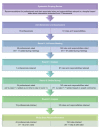Determining Possible Professionals and Respective Roles and Responsibilities for a Model Comprehensive Elder Abuse Intervention: A Delphi Consensus Survey
- PMID: 26630030
- PMCID: PMC4667924
- DOI: 10.1371/journal.pone.0140760
Determining Possible Professionals and Respective Roles and Responsibilities for a Model Comprehensive Elder Abuse Intervention: A Delphi Consensus Survey
Abstract
Objective: We have undertaken a multi-phase, multi-method program of research to develop, implement, and evaluate a comprehensive hospital-based nurse examiner elder abuse intervention that addresses the complex functional, social, forensic, and medical needs of older women and men. In this study, we determined the importance of possible participating professionals and respective roles and responsibilities within the intervention.
Methods: Using a modified Delphi methodology, recommended professionals and their associated roles and responsibilities were generated from a systematic scoping review of relevant scholarly and grey literatures. These items were reviewed, new items added for review, and rated/re-rated for their importance to the intervention on a 5-point Likert scale by an expert panel during a one day in-person meeting. Items that did not achieve consensus were subsequently re-rated in an online survey.
Analysis: Those items that achieved a mean Likert rating of 4+ (rated important to very important), and an interquartile range<1 in the first or second round, and/or for which 80% of ratings were 4+ in the second round were retained for the model elder abuse intervention.
Results: Twenty-two of 31 recommended professionals and 192 of 229 recommended roles and responsibilities rated were retained for our model elder abuse intervention. Retained professionals were: public guardian and trustee (mean rating = 4.88), geriatrician (4.87), police officer (4.87), GEM (geriatric emergency management) nurse (4.80), GEM social worker (4.78), community health worker (4.76), social worker/counsellor (4.74), family physician in community (4.71), paramedic (4.65), financial worker (4.59), lawyer (4.59), pharmacist (4.59), emergency physician (4.57), geriatric psychiatrist (4.33), occupational therapist (4.29), family physician in hospital (4.28), Crown prosecutor (4.24), neuropsychologist (4.24), bioethicist (4.18), caregiver advocate (4.18), victim support worker (4.18), and respite care worker (4.12).
Conclusion: A large and diverse group of multidisciplinary, intersectoral collaborators was deemed necessary to address the complex needs of abused older adults, each having important roles and responsibilities to fulfill within a model comprehensive elder abuse intervention.
Conflict of interest statement
Figures
References
-
- Department of Justice. Abuse of Older Adults: Department of Justice Canada Overview Paper. Ottawa, ON: Department of Justice Canada. 2009.
-
- Division of Violence Prevention. Elder Abuse: Definitions. Centers for Disease Control and Prevention, National Center for Injury Prevention. 2014.
-
- Heisler CJ. Elder abuse and the criminal justice system: New awareness, new responses. Generations. 2000;24(2):52–58.
-
- Bonnie RJ, Wallace RB. Elder Mistreatment: Abuse, Neglect, and Exploitation in an Aging America Washington, DC: The National Academies Press, 2003. - PubMed
Publication types
MeSH terms
Grants and funding
LinkOut - more resources
Full Text Sources
Other Literature Sources
Medical
Research Materials




